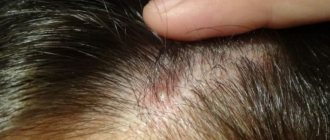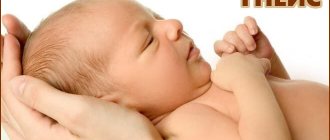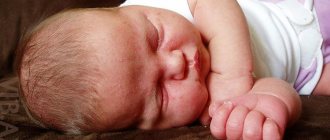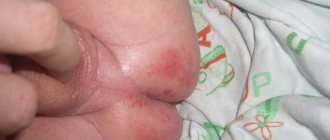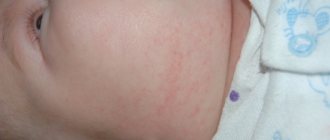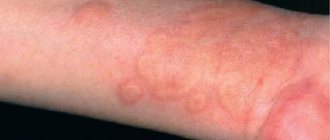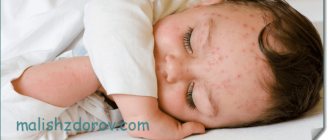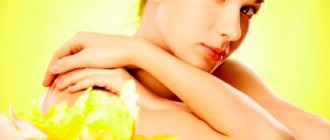New parents examine their baby daily and become nervous if something unknown is discovered. Often we have to deal with the appearance of red spots on the baby’s tender cheeks. This causes anxiety for parents, but it is quite possible to get rid of the problem.
Characteristic rashes can occur for various reasons. Based on them, an effective treatment method is selected.
All spots are divided into 2 main categories: those that do not require specific treatment and those that do need it.
The first reason is diathesis
It is worth knowing that diathesis is not a disease, but a response of the adapting body of a newborn child to a possible stimulus.
In newborns, exudative diathesis is most often diagnosed. It is characterized by skin rashes and inflammation of mucous surfaces. Diathesis is a harbinger of food allergy. And if a child has typical rashes, then the mother should be more attentive to her baby.
The following foods can provoke the development of diathesis:
- cow's milk;
- vegetables and fruits (after the introduction of complementary foods).
If the cheeks of a baby receiving breast milk turn red, then most likely the baby’s mother is to blame. Errors in the nutrition of a nursing mother - the presence of chocolate, strawberries or other allergenic foods in the diet - may well provoke diathesis.
Diathesis is mainly diagnosed in children under two years of age. Manifestations of pathology may periodically intensify and subside. Quite often, in children, due to diathesis, a secondary allergy is formed, the concomitant disease of which is bronchial asthma and atopic dermatitis.
General symptoms of diathesis
Signs of diathesis, in addition to the characteristic redness of the cheeks, are:
- the appearance of prickly heat and diaper rash;
- “crusts” on the head.
If diathesis is severe, the damaged surface of the skin becomes very dry and may even become covered with cracks. All diathesis rashes are very itchy, which causes great anxiety for the baby.
Treatment of diathesis
The basis of pathology therapy is a review of the child’s diet. It is worth noting that when breastfeeding, diathesis in a child is observed in very rare cases. If rashes do appear, then experts recommend introducing vegetable purees into the child’s diet - if age allows. In artificially-bred children, diathesis appears as a signal of formula intolerance.
Lotions with decoctions of medicinal herbs will help alleviate the child’s condition. For severe diathesis, special ointments are used. Sometimes a child may be prescribed antihistamines, enzymes and hepaprotectors that restore liver function.
Varieties and their symptoms
It is difficult to independently determine the cause of a rash on a child’s face. Pimples can appear at different ages. Some of them are localized on the face. Others can affect the head, neck, and torso.
For an accurate diagnosis, an examination by a doctor is required. The pediatrician will prescribe additional examinations. It is important to pay attention to external manifestations.
A significant role is played by:
- location;
- extent of skin damage;
- the presence of accompanying symptoms (itching, burning, pain);
- size of rashes;
- the presence of inflammation or abscess;
- general well-being.
Experts identify several types of rashes that affect the face. Some of them require close monitoring and drug therapy.
The School of Dr. Komarovsky will tell you about different types of rashes:
Prickly heat
A child's sweat glands are imperfect. Because of this, thermoregulation processes in children do not proceed the same way as in adults. Miliaria is one of the most common causes of rash.
It is difficult to distinguish it from other conditions on your own. Difficulties with differentiation are associated with the presence of several varieties.
- Miliaria rubra. The surface of the skin changes color. In severe cases, it turns bright pink. Rashes form with cloudy contents inside. A red tint to the epidermis indicates inflammation.
- Crystalline prickly heat. A large number of bubbles with transparent contents form on the skin. When touched and pressed, they burst easily. There is no redness with this form.
- Papular miliaria. It manifests itself as a pinpoint rash on the face and body. It can form quite large accumulations on the skin.
- Infected heat rash. This is a complicated option. The diagnosis is made if microbes enter the wound formed when the vesicle ruptures. Bacteria provoke an inflammatory process.
Possible suppuration of the affected area , deterioration of health, rise in temperature.
The rash appears due to problems with the functioning of the sweat glands. Prickly heat can be caused by various factors. The main ones are:
- indoor humidity;
- lack of hygiene;
- excessive insulation of the child;
- use of synthetic underwear and clothing.
Miliaria affects not only the face. Often the rash appears on the neck, armpits, shoulders, and then spreads throughout the body.
If the condition is not complicated by infection, the child feels normal. Pimples do not cause discomfort and do not cause itching.
Miliaria is a disease of newborns. What do you need to know? Watch the video about this:
Allergic reactions
During the first year of life, a baby actively gets acquainted with new foods. After 6 months, it is recommended to introduce complementary foods. Before this, he receives breast milk or formula.
The digestive system continues to develop after birth. Any unsuitable product may cause an allergic reaction. Attentive parents will notice the appearance of a characteristic rash on the baby’s face.
Such rashes are a manifestation of the body’s immune reaction in response to irritants. Among the allergens:
- food products;
- wool;
- dust;
- medicines;
- cosmetics;
- household chemicals;
- pollen.
Most often, allergic dermatitis is observed with the introduction of complementary foods. If the baby is breastfed, then the reason will be a violation of the mother's diet.
A rash caused by food allergens is most often localized on the cheeks and chin .
There may be redness in these areas of the skin, but no pimples. The baby is bothered by severe itching.
People often ask: does Linex help with diarrhea in a child? How and how much to give the medicine? Our publication will provide answers to questions.
Read about the symptoms and treatment of atopic dermatitis in children in this article.
Symptoms and treatment of acute adenoiditis in a child are discussed in this material.
Newborn acne
Not all facial rashes require treatment. Newborn acne goes away on its own.
The appearance of a strong, small red rash on the face of a month-old baby, like pimples, can frighten parents. These rashes are hormonal in nature. Every fifth child is susceptible to their development.
Acne is localized mainly on the face. Pimples cover the forehead, nose, chin and cheeks. Some of them are filled with purulent contents. Dermatologists call them pustules. In appearance they are close to teenage acne.
Acne does not cause discomfort. Pimples do not cause itching. In most children, this phenomenon disappears on its own at 2-3 months. In rare cases, rashes persist for up to 1.5 years. Then we talk about baby acne.
Small white nodules on the baby’s nose or under the eyes should not cause concern. Many babies are born with milia on their face.
These rashes are associated with blockage of the sebaceous ducts . They also go away without treatment.
Doctor Komarovsky's school will talk about rashes in newborns:
Erythema toxicum
Newborn babies gradually adapt to their environment. During adaptation, a restructuring of all body systems occurs.
The child learns to eat and breathe differently.
During the period of perestroika, red pimples often appear on the face; they have gray heads. The rash affects the face and scalp.
Erythema toxicum is not dangerous. The rash goes away within a few days.
Infectious diseases
Older children are also more likely to develop rashes. Parents should be careful, as pimples may indicate an infection.
- Chicken pox.
This is a viral disease, which is characterized by the appearance of red lumps on the skin. Rash on the face and body. The spots transform into bubbles. The latter burst and a crust appears. With chickenpox, your body temperature rises. Possible enlarged lymph nodes. - Rubella. The rash can be either large or small. The child is showing signs of ARVI. Your throat may hurt. Its mucous membranes usually turn red and swell.
Rubella rashes disappear after 5 days. During this period, a slight rise in temperature is possible.- Scarlet fever. When the disease occurs, pimples appear on the face and then spread throughout the body. They are bright red in color and noticeably rise above the skin. The temperature rises, signs of a sore throat appear.
- Measles.
This viral disease is always severe. Pink spots appear in the early stages. The predominant place of their localization is the forehead. Further, the spots merge into large formations . Symptoms other than a rash on the face may be observed: runny nose, cough, diarrhea, headache, temperature rises to 40 degrees.
A distinctive feature of any infectious disease is an increase in temperature.
Children's viral infections are easily transmitted by airborne droplets. The same disease does not develop twice. The child develops a strong immunity to any of the infections.
Possible causes of redness and peeling of the skin when red spots appear on a child’s face
Skin sensitivity is expressed by the main symptoms:
- Feeling of tightening of the face after hygiene procedures.
- Tendency to irritation and peeling.
- Periodic appearance of spots or pigmentation.
- Negative reaction to fresh cosmetics.
- Sun intolerance.
Also, this skin type may be due to:
- Low-quality cosmetics. It is this factor that tires and makes the skin weak. Incorrect skin care products not only destroy the lipid layer, but also lead to loss of water in the skin.
- Unfavorable factors. The influence of wind and sun has a brutal effect on human skin. Sensitive skin can even react to the presence of heaters in the room.
- Stress factor. A previous illness or diet can lead to increased skin sensitivity. Disturbances in the functioning of the endocrine system can also cause dryness or inflammation.
- Innateness. Some people have dry skin since adolescence. Then such sensitive skin needs a certain type of cosmetic products.
What happens to a child’s face when exposed to demodex mites?
If a child has problems with the gastrointestinal tract, a disease called demodex may occur. Its carrier is the demodex mite, which feeds on dead skin cells. The main symptom of this disease is the presence of pustular pimples, most often located on the forehead, cheeks, and nasal wings. Often a rash on a child’s face; photos of all types of rashes are confused with this disease. Since demodex also has red spots and allergic reactions, excluding food does not solve this problem, but rather will only aggravate it.
To confirm the disease, an examination by doctors is required, but treatment requires an integrated approach. The use of various drugs must be strictly controlled and the best care taken in terms of the child’s hygiene. Walking in the fresh air and consuming freshly washed vegetables and fruits are required. As well as maintaining a stable cleanliness regime in the house, including the absence of dust and unnecessary pollution. Despite all of the above, a prerequisite for a cure for this disease will be consultation with a specialist, which guarantees a cure for this harmful disease.
The second reason is a pseudo-allergic reaction
Red cheeks in a baby may be the body's reaction to a certain food product. But it turns out to be caused not by the production of antibodies, but by a lack of digestive enzymes.
Only a specialist can confirm the diagnosis. In this case, the child is not prescribed treatment, since the baby’s gastrointestinal tract becomes more and more advanced with age. And such manifestations pass on their own. The only thing that is required from the child’s mother is to carefully monitor the baby’s diet.
Allergic diseases
Allergies may cause burgundy spots on the face, which are often accompanied by rashes on different parts of the body:
- neck;
- breasts;
- hands;
- stomach;
- legs.
The reasons for the occurrence of such spots can be different.
Often the rash goes away immediately after the negative effect on the body is eliminated. In children, allergic rashes occur after eating a huge amount of sweets.
Rubella in children
Rubella in a child is a fairly well-known and harmful disease, characterized by the appearance of pale pink and red spots on the body. Important signs indicating the presence of this disease are fever, headaches, lethargy, signs of ARVI (redness in the throat, runny nose, dry cough). The rash spreads quickly across the body and can be seen first on the face, neck and top of the head. However, they may disappear by the time the entire body is covered with such spots. The temperature lasts up to two days, the lymph nodes continue to be enlarged until the rash disappears. After rubella disappears, the skin remains dry, with periodic peeling.
To diagnose rubella, it is necessary to provide bed rest and limit eye strain. At a temperature of 38 and above, it is necessary to take antipyretics, and itching is relieved with antiallergic drugs. The throat can be treated with topical sprays, and nasal congestion can be treated with rinses with various water and salt based solutions. In order to avoid the appearance of rubella, it is necessary to undergo vaccination in several stages. If there are many people in the house, the patient should be isolated in a separate room, and his clothes should be disinfected.
The fifth reason is pneumonia
The causes of red cheeks in infants can also be quite serious diseases, in particular pneumonia. That is why it would be useful for mothers to know the typical symptoms of this disease.
Pneumonia is quite often diagnosed in children who spend very little time outdoors. And the baby can get sick even with the slightest change in temperature.
Symptoms of pneumonia
Signs of pneumonia include:
- red cheeks combined with pale lips and the tip of the nose (this is a characteristic symptom of the disease);
- lethargy of the child;
- poor appetite (the baby may even refuse to eat altogether);
- high body temperature (it goes down very hard and does not last long);
- heavy rapid breathing;
- the child may feel sick (rarely);
- coughing.
Treatment of the disease is carried out inpatiently. Only in this case can serious complications be avoided.
Sunburn
Inflammatory processes on the skin after taking a large number of ultraviolet baths or similar light are called sunburn.
In order to distinguish the signs of a burn from other circumstances of the appearance of a spot on the face, you should pay attention to the symptoms:
- At the site of the burn, the skin becomes red and inflamed. Touching the affected area causes pain.
- A few days after the burn, swelling occurs. In some cases, blisters or rashes may occur.
- Increased body temperature.
If the degree of sunburn is small, the inflammation will go away in a few days.
But if languid sun damage is observed, skin defects may form:
- ulcers;
- erosion;
- photodermatoses;
- malignant neoplasms;
- pigmentation.
Sunburn acquired in childhood several times increases the likelihood of developing skin cancer in the future.
Therefore, when taking ultraviolet baths, do not forget about safety in the form of sunscreen cosmetics.
Read more about skin cancer and see photos of the initial stage of melanoma.
What does food allergy on the face mean?
Food allergies are quite widespread, like a rash on a child's face. Photo, all types of rash are different from the one that will be discussed in this paragraph. It is not always possible to distinguish it from simple food intolerance. Because the main sign, which is the participation of immune cells in the reaction, can only be recognized in the laboratory. But unlike allergies, intolerance appears after the first contact with food and is accompanied by stomach diseases. The most allergenic foods are honey, nuts, fish, milk, and chocolate products. Alcohol and sugar consumption also contribute to increased allergies. Symptoms of this disease are itching, redness, small rash, and swelling. If the allergy is not recognized in time, the disease will further develop and develop into a severe form. An extreme case would be the appearance of Quincke's edema, requiring immediate surgical intervention. To prevent food allergies, a full-scale examination is required with the prescription of appropriate treatment and antiallergic drugs.
Reason seven – helminthic infestation
A red rash on the cheeks may be a symptom that the child is infected with parasites. To make a diagnosis, tests are also prescribed.
Before drawing conclusions and confirming the baby’s diagnosis, it is necessary to take into account many factors. And in order not to miss the onset of a serious illness, it would be prudent to play it safe and show the baby to a pediatrician. After all, only a qualified specialist will be able to make a preliminary diagnosis, which will either be confirmed or refuted after the tests are performed.
We also recommend watching:
- Diathesis in infants: treatment
- Food allergies in infants
- Atopic dermatitis in infants
- Miliaria in newborns
Treatment
An allergic disease must be diagnosed by a qualified specialist in this field, who is able to determine the best way to treat the disease. As a rule, in each case, individual treatment tactics for children are selected, primarily involving the exclusion of contact with allergens.
- In almost every case, it is recommended to prescribe antihistamines. Unlike the treatment of an adult patient, it is preferable to use liquid solutions (drops, syrup) for a child. They are most convenient to use for a child and do not cause negative side effects. The required dosage depends on the age of the baby, the general condition of the body and the severity of severe symptoms.
- Some of the most common medications for relieving allergies in infants are Polysorb (enterosorbent) and Fenistil (drops, ointment). Pediatricians often advise combined treatment with simultaneous lubrication of the rash-affected cheeks and ingestion of antihistamine drops. Polysorb is prescribed to quickly remove various allergens from the body. In addition, its advantage is its inability to be absorbed into the blood. Therefore, this enterosorbent is considered to be the safest, which is approved for use for children from the first days of life.
ethnoscience
Some parents prefer to cope with allergies in their newborn child using traditional medicine. However, it should be remembered that even the most harmless drugs, including herbs, have their contraindications, so before treating allergic manifestations in a baby, a preliminary consultation with a doctor is required so as not to harm the baby’s body. It is important to remember that such treatment is carried out with caution in young children.
We should not forget that treatment of infants with medicinal herbs cannot completely replace drug therapy. Allergies need to be treated comprehensively, using all means. Only in this case will the treatment be successful.
Compresses and lotions using pharmaceutical chamomile, thyme, and celandine have a good effect when treating a newborn baby. These herbs help quickly get rid of red spots on the cheeks.
Compliance with preventive measures is of great importance. You should adhere to a hypoallergenic diet, excluding harmful foods from your child’s diet.
In addition, it is recommended to promptly neutralize an acute attack of allergies, avoiding complications. And most importantly, all therapeutic measures should be carried out only with the permission of the attending physician. Only with this approach can antigens be removed from the patient’s body.
A rash on a child’s face, photos, all types of rashes - this is what will be discussed in this article. After all, a rash is a serious problem, as it spreads rapidly throughout the body and can turn into a difficult-to-treat disease. In the future, we will consider how to recognize this in a child and what signs they have.
Autoimmune diseases
Such disturbances in the functioning of the entire body are often provoked by the human immune system. For unknown reasons, the immune system begins to recognize the body's cells as foreign. The body begins a destructive action against itself. Such diseases affect entire organ systems, and they require complex therapy.
The reasons for the uncontrolled anger of the body’s defenses are:
- Internal type:
- Type I gene mutations. Lymphocytes simply cannot distinguish between the types of cells in the body. These diseases include thyroiditis or toxic goiter.
- Type II gene mutations. In addition to anger, blood cells provoke their uncontrolled reproduction in the body. These diseases include lupus and multiple sclerosis. Often these tasks appear due to heredity.
- External reasons:
- Infections. Protracted diseases of this nature can cause disruptions in the functioning of the immune system.
- Harmful influence of the environment.
- Biological deception of the body's defenses by unhealthy cells. In this case, lymphocytes lose the ability to distinguish between opponents and friends.
How to get rid
Redness on the cheeks cannot be ignored. If the blood vessels are close to the surface of the skin, any environmental influence causes the constant appearance of red areas; this manifestation does not require treatment. To stay outdoors, it is necessary to apply a protective composition.
If redness is associated with other diseases, such as cardiovascular diseases, appropriate therapeutic measures are prescribed that are aimed at eliminating the root cause. This applies to hormonal imbalances and treatment of dermatitis. Therapeutic measures should be prescribed by a dermatologist. When carrying out therapy it is necessary:
- stick to a diet;
- exclude certain foods;
- refuse cosmetic creams;
- forget about prolonged exposure to the sun;
- do not abuse alcohol.
We suggest you read: Itchy head and how to treat sores
How to help your child
In order to help your child, it is important to understand the nature of the rash. A pediatrician will help with this and, if necessary, will refer you to a more specialized specialist - a dermatologist, infectious disease specialist, or allergist.
After making a diagnosis and carrying out the necessary examinations, medications are prescribed to relieve skin itching, as well as the necessary medications for allergies and infectious diseases.
The doctor gives complete recommendations for caring for delicate baby skin and monitors the child’s condition.
Depending on the cause of the rash, the following is prescribed:
- external topical preparations (ointments, creams, gels);
- soothing baths (herbal, healing);
- medications (antihistamines for allergies, antibiotics for infections);
- nutritional recommendations for mother and baby.
Treatment of the skin on the cheeks with preparations
Before applying any product to your baby's skin, you should always consult your doctor.
Typically, drying creams are used that eliminate the rash visually and reduce itching:
- Bepanten;
- Dexpanthenol;
- Drapolene;
Treatment with folk remedies
A beneficial effect on a baby's skin with a rash can be achieved by using herbal baths or gently rubbing the rash areas with certain decoctions.
Traditional medicine recipes:
- bay leaf - it is recommended to bathe the baby, adding brewed bay leaf to the water, and also wipe the rash areas with the broth using gentle movements 2-3 times a day;
- chamomile, string - brewed herbs are also added to the water when bathing and problem areas are wiped several times a day;
- potassium permanganate - has a strong anti-inflammatory effect, suitable for use for rashes, both allergic and bacterial in nature. Several crystals of potassium permanganate are dissolved in water for bathing a child.
Diet for mothers during breastfeeding, permitted and prohibited foods
Strict dietary restrictions for a nursing mother are not always able to produce tangible results. However, with atopic dermatitis and numerous rashes in a child, women should exclude from their diet foods that can cause an allergic reaction.
| Strictly prohibited products | Milk, exotic vegetables and fruits, as well as other brightly colored ones, eggs, chocolate, honey, nuts |
| Carefully | Currants, blueberries, peaches, chicken, peas, beans, |
| Allowed | Dietary meat (rabbit, turkey), zucchini, buckwheat, green apples, broccoli |
Types of skin rashes
There are many types of skin rashes that are easy to distinguish with the naked eye. It is customary to distinguish the following groups:
For most diseases, a rash is not the primary symptom. Most often, general weakness of the body, loss of appetite, hyperthermia, chills, and sometimes nausea and cough are first observed. If the appearance of red spots on the skin of a child is accompanied by an increase in temperature, then you should immediately consult a doctor, as this indicates the presence of an infection or virus in the body.
What does urticaria look like in a child?
This disease is easy to diagnose independently; most often it affects children under 3 years of age. Often it appears in the form of small dots. A rash on a child’s face, photo, all types of rashes should be examined very carefully. They are distinguished by the presence of a reddish tint and blisters, which increase in size when scratched. The cause of urticaria in children is the entry of an allergen into the body, which causes the production of an increased amount of histamine, leading to thinning of the walls of blood vessels. In this case, the urticaria disappears quite quickly, within two hours, appearing in another place almost immediately. The irritants are:
- Food products such as milk, eggs, chocolate, fruits and more.
- Infections from viruses, bacteria.
- Medications.
- Impurities such as pollen, dust, fluff and the rest.
- Nickel, resin.
- Dyes.
Drug allergies
When drug therapy is carried out, the effect of their chemical components on the child’s body often causes immune reactions. Often, allergies occur to synthetic vitamins and antibacterial agents. Reactions are observed to vaccine components, which is not uncommon today. The greatest danger is posed by DPT, vaccinations against measles and influenza viruses. Depending on the extent and type of lesion, clinical manifestations vary. A large red spot may appear on the child's cheek or a rash all over the body.
Measles and what it looks like
Measles is an acute infectious disease caused by a special type of virus that rarely survives outside the human body. With measles, large spots and rashes appear on days 1-3, which spread over the face, ears, and then throughout the body. All this happens five days after the previous stage. Before this, a runny nose, swelling and damage to the mucous membrane occurs. The appearance of white spots with a red border is noted. They are considered a typical sign of measles. After ten days, all signs of the disease disappear, leaving traces of pigmentation throughout the body. Sometimes measles causes complications for the respiratory tract, and in severe stages pneumonia occurs. Diseases of the circulatory system and measles encephalomyelitis, often leading to death, are also possible. In order to avoid complications, preventive vaccination should be carried out at 12 months and 6 years; immunoglobulin is used for emergency cases.
White dots with stomatitis
The easiest way to diagnose white spots on the inside of a child’s cheek. In 95% of cases it is candidiasis or aphthous stomatitis. Milky inclusions and spots are easy to notice when examining the oral cavity. There is always redness and slight itching around them, and an accumulation of cheesy plaque.
To quickly stop the disease, you should carefully treat the baby’s mouth with antiseptics at least 3 times a day:
- Miramistin;
- Chlorhexidine;
- Lugol's pharmaceutical solution with iodine;
- warm water with soda.
Red dots appear due to yeast activity. Therefore, 4-5 times a day, the inside of the cheeks is wiped with Candida solution, Levorin or Nystatin ointment. If the aphthae is very itchy, it is recommended to give the small patient antihistamines: Diazolin, Tavegil, Eden.
For children over 5 years old, Decamine caramel is offered as a convenient way to treat candidiasis. The drug dissolves easily like a regular candy and leaves an invisible film of antifungal agent. The pathogen quickly dies, discomfort and pain in the mouth stops.
You should definitely boost your immunity with vitamins, complexes with Echinacea purpurea extract and propolis. Light herbal decoctions without adding alcohol based on calendula and chamomile flowers are allowed as folk recipes. The gums and cheeks are smeared with a paste of honey and aloe pulp, and wiped with sea buckthorn oil.
What does prickly heat look like in a child?
Miliaria in children is an irritation that appears as a very small rash in the form of a vesicle with liquid inside. It most often affects infants and young children. Rash on a child’s face, photo, all types of rash have specific signs, which include skin itching, swelling, increased sweating, and weeping skin. The reasons why this disease occurs are improper hygiene care, too much clothing in warm weather, greasy creams, and problems with sweating. However, prevention and treatment are quite simple; the main condition is maintaining a comfortable regime, using special ointments, powders and talc. It is also strongly recommended to bathe the child in a bath with the addition of herbal infusions, such as St. John's wort or celandine. If this does not help, then you need to go to an appointment with a dermatologist. Since most likely there are bacterial infections in the body that need immediate treatment. Only by following all the doctor’s recommendations is it possible to remove this disease from the child’s body.
